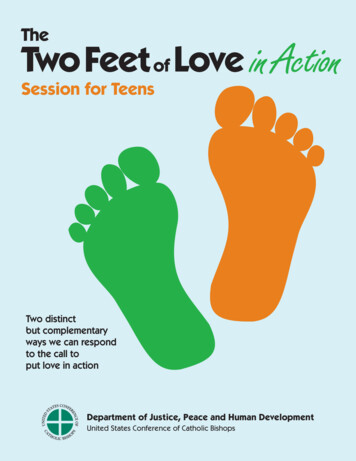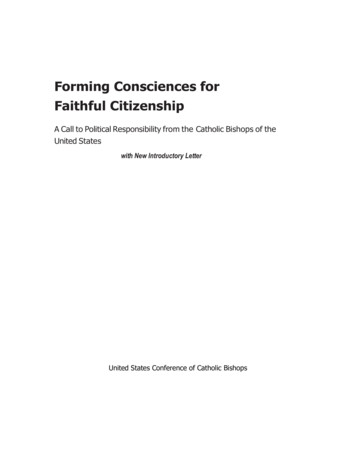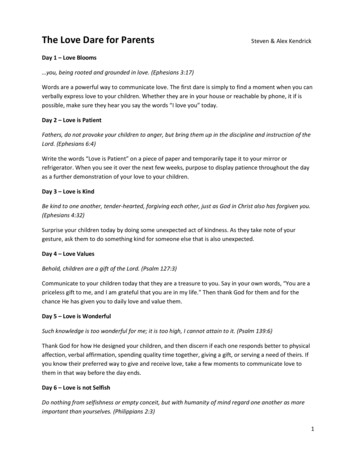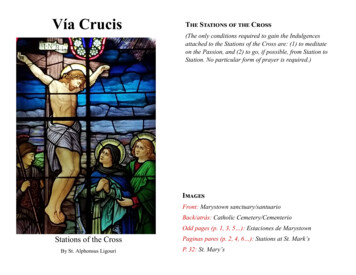
Transcription
TheTwo Feet of LoveSession for TeensTwo distinctbut complementaryways we can respondto the call toput love in actionDepartment of Justice, Peace and Human DevelopmentUnited States Conference of Catholic Bishops
Session for TeensIntroductionIn Deus Caritas Est, Pope Benedict XVI describesthe “unbreakable bond between love of God andlove of neighbor” (no. 16). The experience ofGod’s love, he says, should move us to love ourneighbors, in whom God is present.Who are our neighbors? In the Gospels, Jesusanswers the question with the parable of the GoodSamaritan—the beaten man on the road who hadno one else to care for him. Pope Benedict XVItells us that the “extraordinary force” of loveshould propel us, as disciples of Christ, to actionon behalf of such neighbors (Caritas in Veritate,no. 1). In the same way, Pope Francis notes: “Aprayer that does not lead you to practical actionfor your brother—the poor, the sick, those in needof help, a brother in difficulty—is a sterile andincomplete prayer” (Angelus, 7/21/13).Session Outline(90 minutes)I.Icebreaker Game – 15 min.II.Opening Prayer – 5 min.III. Stack of the Deck Game – 15 min.IV. Introduction to the Two Feet ofLove in Action – 15 min.V.Discussion – 15 min.VI. Walking the Path of Love– 15min.VII. Sending – 10 min.VIII. Closing Prayer – 2 min.What should our loving action look like? TheCatholic tradition recognizes two types ofnecessary responses that we call the Two Feet ofLove in Action.This facilitator’s guide can help you as you lead a group of high school age participants tolearn about and reflect on living out the call to discipleship through these two distinct, butcomplementary, ways of responding in love to the needs of our neighbors. If there areparticipants with disabilities in your group, be sure to consult “Tips to Adapt Activities forParticipants with Disabilities” on pages 42-43 before you begin.Materials NeededItalicized items are for non-classroom settings, such as a youth group. Dry erase board, flipchart, or chalkboard Markers or chalk Icebreaker quotes, copied and cut apart (pp. 12-17) and construction paper and glue ORmaterials for relay race (p. 3), including these items for each group: full cup of water;toy building blocks; Band-aids; and math worksheet (p. 18) Untied shoe (To make things harder you could have shoes with knots in the laces thatthe participants must untie, put on, then retie) 3 decks of cards (for the “Stack of the Deck” Game, pp. 22-27)1
One copy of handouts per participant*:o Opening and Closing prayer (p. 19)o Two feet worksheets (pp. 20-21)o Poverty Statistics (p. 27)o Sending (p. 36)o Quotes page (pp. 37-38)o Resources handout (pp. 39-41) 1 “foot” per participant from the Walking the Path of Love activity (pp. 28-34) Writing utensils Masking tape*Note: To save paper, consider copying handouts back to back. Or, consider projecting the Opening and ClosingPrayer, Poverty Statistics, and Two Feet worksheets as PowerPoint slides instead of printing them.I. Icebreaker GameThere are two introductory game options in this lesson plan. The first is intended for aquieter, space-restricted setting while the second is a noisier, sillier game which might fitbetter in a setting where noise or space may not be as much an issue. If your groupincludes participants with disabilities, please consult the “Tips to Adapt Activities forParticipants with Disabilities” on pages 42-43 before you begin.Option 1: Quote Game (use in quieter, space-restricted setting)Before the session, estimate your expected group size and then copy the quotes on pages12-13, or pages 14 -17, depending on the size of your group. Cut on the dotted lines sothat the parts of the quotes will be on small slips of paper. (Optional: If you think that thequotes may be too difficult for your group, you can provide “clues” by writing “Scripture,”“Catechism,” “Compendium,” “Pope Benedict XVI,” or “Pope Francis” in small letters on theslips of paper.) Mix up or shuffle the pieces of paper to make sure they are not in order.Give each participant one of the slips of paper. Explain to participants that they have onlypart of a quote and that they need to find the other person or persons in the room whohave the other part(s). Participants must introduce themselves to one another as they tryto complete their quotes.Remember, if you have more than 36 participants, you can feel free to repeat quotes. Also,if you are handing out slips of paper as people arrive and do not know the exact number ofparticipants who will attend your session, you can avoid having some participants end upwith partial quotes by doing the following: make a conservative estimate of the number ofparticipants you expect and cut up quotes for only that number of people. If you areuncertain of the exact number of people you are expecting, consider having a back-upbatch of additional slips of paper to hand out only after the initial batch is depleted.2
Distribute the back-up slips only a few quotes at a time to avoid a situation in whichsomeone has a partial quote that doesn’t match anyone else’s.When a group of participants believes it has completed a quote, check to make sure thequote is correct. (You may want to have pages 12-13 or 14-17 handy so you can easilycheck the quotes. Or, you can instead print out the take-home quotes page from pages 3738 to use as your answer key.) If the quote is correct, ask the participants to glue the fullquote to a piece of construction paper. Explain to the group that the quotes help tointroduce the topic for our session today: how we can respond to Christ’s call for us to loveour neighbors. Ask each group to read their quote out loud to the group and then tape it onthe wall of the room.Option 2: Relay race (use in noisier, more spacious setting)Preparation:In this game, teams of five will participate in a relay race. Divide the number of participantsby five and set up one table or desk per team at one end of the room, and use one longpiece of tape as a starting line on the other end. Make sure that there is a lot of openspace between the starting line and the tables, as the participants will be running back andforth.Place the following materials on each team’s table (each group should have all of thesematerials): Full cup of water (Note: if you are doing the relay on hard floor that could beslippery if wet, you can substitute the water for something else non-liquid such asfeathers or pencils that are taller than the cup and tough to keep inside.) Toy building blocks – enough to build a house (at least 14 long blocks and 2 squareblocks) or some other material (such as Legos, cardboard pieces, toilet paper rolls,and tape) that could be used to construct a house. Box of Band-Aids Math worksheet (found on page 18) Untied shoe – Ask one person from each team who is wearing tennis shoes oranother type of shoe with laces to remove one shoe from his or her foot, retie itwith a double knot, and place it on the table for his or her team on the other side ofthe room. (To make things harder you could also instruct the person to makeseveral knots in the laces.)Have each group stand at the starting line opposite each table and then explain the rules: All activities must be completed using one leg only. Every group member must wait for the person before him or her to be completelyfinished with his or her task before crossing the start line.3
The first person must hop down to the other side of the room, grab the cup of waterand hop back holding the cup with one hand only. (If using feathers or pencils, youmay want to instruct that the person must stop and pick up any items that fall out.) The next person must hop, grab the box of Band-Aids, hop back, and put one BandAid on every single team member. The next person must hop, correctly complete the math worksheet, and hop backwith the worksheet, which the team members must check over. The next person must hop to the end of the room, grab all of the toy buildingblocks, and hop back. If he or she drops any, pick them up. The team membersthen must start building a house with four walls and a roof from the materials asfast as they can. The last person must hop to the end, untie the shoe, put it on, retie it and hop back.Thus, the person whose shoe is on the table should be the last person in the team’sline. The first team done wins a prize! (food, free bowling passes, etc.) The team musthave finished the relay and all of the tasks, which include successfully transportingthe water cup, putting Band-Aids on every team member, completing the mathworksheet correctly, building a house (four walls and a roof), putting on the shoe.At the end of the game, ask the participants if having to hop on one foot made the gamemore difficult. Tell them we’ll return to that theme later on in the session!II. Opening PrayerPass out (or project) the opening prayer (page 18) and pray together:Prayer for Peace and JusticeGod, source of all light,we are surrounded by the darkness ofthe injustices experienced by your people,the poor who are hungry and who search for shelter,the sick who seek relief,and the downtrodden who seek help in their hopelessness.Surround us and fill us with your Spirit who is Light.Lead us in your way to be light to your people.Help us, [insert group name] to be salt for our communityas we share your love with those caught in the struggles of life.We desire to be your presence to the least among usand to know your presence in them as we work through youto bring justice and peace to this world in desperate need.4
We ask this through our Lord Jesus Christ,your son, who lives and reigns with youand the Holy Spirit, one God, for ever and ever.Amen.Source: Communities of Salt and Light Parish Resource ManualIII. The Stack of the Deck Game:To help participants understand the problems of poverty today you can play the “Stack ofthe Deck Game”. See page 22 for instructions on how to run this game. The gameillustrates how the advantages or disadvantages into which a person is born and his or herchoices in life can influence his or her well-being and opportunities. As Christians, we are allpart of one Body of Christ, whether we are born into riches or poverty. We are called asChrist’s disciples to work together to ensure that all people can live with dignity anddevelop as children of God.Optional: Show participants the Catholic Campaign for Human Development’s Poverty Tourvideo. verty-usa-tour/)After the game and/or video, project the statistics from page 26 on a PowerPoint slide, ordistribute them as a handout.Have participants break up into small groups for discussion, designating one person to bethe recorder, and another to report back on the group’s discussion. Have groups spendabout five minutes discussing the question below.Question: Does everyone have a fair start in life?Ask the participants to reflect on the question in light of the Stack of the Deck Game thatthey just played. Another way of asking the question is “Was there a level playing field forboth of the people in the game, or did one of them have an advantage? Why or why not?”The participants can also consider the statistics, which reflect some of the problems facedby the worse-off person in the game, to inform their answer to the question.IV. Introduction to the Two Feet of Love in ActionBefore explaining the Two Feet of Love in Action, see how participants respond to ascenario. Tell the participants that because of the “deck” that the worse-off person endedup with, that person has found that he or she doesn’t have enough money to pay his or herrent because his or her job pays a very low wage. He or she has been evicted from his orher apartment, along with his or her two children. In recent years, there have increasinglybeen many other families in the same boat. How would you help them? Most likely, theparticipants’ responses will be Charitable Works responses, although they won’t know that5
term yet. Have participants offer ideas of how, as people of faith, we could respond. Writethe responses on the board. Save these for later, as you will return to this scenario at theend.After the group has given its responses, explain that as disciples of Christ, who showedspecial concern and love for those in need, we are called to be concerned about issues thataffect poor, vulnerable, and marginalized persons. Our concern for those in need and ourdesire to help flows from our love for God and neighbor. In the Gospels, Jesus told us thatlove for God and neighbor are the most important commandments, and that because Godloves us and all people, we should also love our neighbors. Pope Benedict XVI explains inhis encyclical Deus Caritas Est, “Love of God and love of neighbor are thus inseparable,they form a single commandment. But both flow from the love of God who has loved usfirst a love which by its very nature must then be shared with others” (no. 18).Explain to the participants that we are able to love because God has first loved us. Uponexperiencing God’s love through prayer and the sacraments, we should want to imitate it.We should want to love all whom he loves.Assign a participant to read the following quote, making sure the participant knows to readslowly while emphasizing the bolded words from Jesus’ parable about the sheep and goats:“Then the righteous will answer him and say, ‘Lord, when did we see you hungryand feed you, or thirsty and give you drink?When did we see you a stranger and welcome you, or naked and clothe you?When did we see you ill or in prison, and visit you?’And the king will say to them in reply, ‘Amen, I say to you, whatever you did for oneof these least brothers of mine, you did for me.’”-Matthew 25:37-40In response to God’s great love for us, we love our neighbor. By loving our neighbor, wehonor God, who loves us and all people. By loving our neighbors, we live out the call todiscipleship that we are given through our Baptism. But how can we put love into action?Distribute (or project) the Two Feet of Love in Action handouts (pages 20-21). Explain toparticipants as they view the handout that there are two different, but complimentary, waysthat we act in response to God‘s love. We call these the Two Feet of Love in Action. Thesetwo “feet”, Social Justice and Charitable Works, allow us to walk the path of caritas, or love.The two feet are:“Foot” # 1: Social JusticeExplain that the first “foot” is called Social Justice. This means praying and working forlong-term solutions to the root causes of problems in our community and the world. Westep with the Social Justice foot through changing laws and public policies. We step with6
this foot by helping low-income people to not only survive, but also to escape poverty. Wealso step with this foot when we support the efforts of low-income persons to transformtheir communities.Stepping with the Social Justice means we are working to help transform the humancommunity so that it better reflects the image of Christ, the most perfect example of love(Catechism, no. 1877).Word StudySometimes it can be helpful to break down the definition of “social justice” so that it isclearer for participants what this term means:“Social” – Has to do with other people or relating to society. We are not isolated individuals;we live and exist with others, in community.“Justice” – Is “the moral virtue that consists in the constant and firm will to give their due toGod and neighbor” (see Catechism of the Catholic Church, no. 1807). Justice prompts us todistribute to God and all people what belongs to them.“Social justice” is ensuring that those in society, our neighbors, can fulfill their basic needs.Church teaching tells us that all people, no matter who they are or where they come from,have a right to what is required for human decency, such as “food, clothing, shelter, rest,medical care, social services, and security in cases of sickness, inability to work,widowhood, old age, or unemployment” (John XXIII, Pacem in Terris, no. 11; Gaudium etSpes, no. 26)Pope Francis tells us that making sure that everyone has access to what they need to livehappy and healthy lives is a matter of justice. He writes: “A way has to be found to enableeveryone to benefit from the fruits of the earth, and not simply close the gap between theaffluent and those who must be satisfied with the crumbs falling from the table, but aboveall to satisfy the demands of justice, fairness, and respect for every human being.”(Address, 6/20/13).“Foot” # 2: Charitable WorksCharitable Works are when you give direct help to people or families to help meet theirimmediate needs. We step with our charitable works foot when we provide food, clothing,shelter or monetary assistance to those in need. Pope Benedict XVI describes our charitableworks as “the simple response to immediate needs and specific situations: feeding thehungry, clothing the naked, caring for and healing the sick, visiting those in prison, etc.”(Deus Caritas Est, no. 31). He is of course referencing the teaching of Jesus himself aboutthe works of mercy in Matthew 25:31-46.7
Likewise, Pope Francis describes this foot when he urges us to perform works of mercy forour “wounded brother, because he is hungry, because he is thirsty, because he is naked,because [he] is humiliated, because he is a slave, because he’s in jail, because he is in thehospital” (Homily, 7/3/13).Word StudyAgain, studying the background of a term can be helpful for understanding the idea as awhole:The word “charitable” comes from the word charity. Charity is the “virtue by which we love God above all things for his own sake, andour neighbor as ourselves for the love of God” (Catechism of the Catholic Church,no. 1882). Charity has to do with love for both God and neighbor. In the Gospels,Jesus answers the question “Who is my neighbor” with the parable of the GoodSamaritan who helped the beaten man on the road who had no one else to care forhim. The virtue of charity calls us to have compassion for our neighbors, or thosearound us who are poor and vulnerable. The suffix “–able” means “in accordance with”.Thus, Charitable Works are actions that are in response to our love for God and neighbor,in accordance with direct generosity or compassion towards those who are most in need ofhelp.Walking with Both FeetUse the following case study and reflection to show participants the Two Feet of Love inAction:Parishioners at St. Camillus parish in Silver Spring, MD were concerned aboutviolence erupting over control of natural resources in the Democratic Republic ofthe Congo (DRC), and they felt that it was their baptismal call and their duty asdisciples of Christ to put their faith in action. They decided to walk with bothfeet. Parishioners organized a trip to Congress to share their concerns, engagingthe social justice foot. This advocacy by St. Camillus parishioners and manyother Catholics played an important role in passing new legislation in 2010requiring companies to take steps to ensure that the minerals used in theirproducts are not supporting violence in the eastern Congo. Back at the parish,parishioners stepped with the charitable works foot by praying for the victimsof violence in the DRS and by holding a craft sale to benefit Catholic ReliefServices programs that assist victims of war in the DRC. These actions helped theparishioners to truly respond to the command given to each of one of them atdismissal from Mass to “glorify the Lord by your life.”8
Reflection:As a large group, have participants answer these questions: How did St. Camillus walk with the Social Justice foot? How did they walk with the Charitable Works foot? Do you have any other ideas of how they could have walked with either the SocialJustice or the Charitable Works foot? [Make sure that participants mention examplefor both feet, not just one.]Critical Thinking:Return now to the example of the worse-off person in the Stack of the Deck game. Nowthat the participants have a better understanding of the two ways to respond, return to thescenario where the person who was less fortunate has found that he or she doesn’t haveenough money to pay his or her rent because his job pays a very low wage. He or she hasbeen evicted from his or her apartment, along with his or her two children. This ishappening to other families as well. How would the participants help them? Look at theideas they brainstormed earlier and ask which category (Social Justice or Charitable Works)each idea falls into.Then ask participants to brainstorm some additional ideas for the “weaker” foot (the footfor which they brainstormed fewer ideas). Some responses may include:Charitable Works: Help support the person financially by paying for rent Act as a spiritual guide and mentor/friend for the person by praying with him or herand accompanying and assisting him or her as he or she applies for new jobs Offer temporary housing for families who become homeless Offer to watch the person’s children so more money can go towards rentSocial Justice: Urge the city council to pass a law to ensure workers are paid fair wages Work with the city to get more affordable housing for low-wage earners Offer job training programs to help low-wage workers get higher paying jobsExplain that as disciples of Christ, we are called to walk with both feet, not just one.One creative way to illustrate this is to invite two volunteers to the front of the roomand tell them they are going to have a race from where they are standing to the wall.However, one person is only allowed to use one foot, while the other can use both feet.After the race, ask: “Was it easier to run with both feet, or just one?” The same is alsotrue for our work as children of God to address issues that face our communities.9
V. DiscussionHave participants break up into small groups, designating one person to be the recorder,and another person who will present what the group discusses. Ask the groups to discussthe following questions: Do you step more heavily with one foot than the other?Which one?How can we “level the playing field” so that disadvantaged people havethe same opportunities as everyone else?What do we do next?After about ten minutes, or earlier if it seems groups are finished discussing, have eachpresenter summarize his or her group’s answers. Take note if any participants seem tohave missed the concept so that you can focus on any problem areas as you discuss theanswers.VI. Walking the Path of LoveNow that participants have a better understanding of what the two feet of love are, helpparticipants understand how they can walk with the two feet of love. Remind them thatdoing so is a response to our baptismal call to discipleship and our response to Christ’scommand to love our neighbors. Walking the Path of Love is a fun game where teams ofparticipants are challenged to be creative and work together to think of social justice andcharitable works responses to a wide range of issues in society. Instructions for the gamecan be found on page 28. If your group includes participants with disabilities, be sure toconsult “Tips to Adapt Activities for Participants with Disabilities” on pages 42-43 before youbegin.VII. SendingAs the session wraps up, allow time for the participants to think about how they willbecome involved in responding to issues in their community. A handout with reflectionquestions can be found on page 36.Explain to participants that as disciples of Christ who are sent on mission through ourBaptism and Confirmation, we are called to continually pray and reflect about how we arecalled to put two feet of love in action. Hand out the quotes on pages 37-38 and suggestthat participants reflect on these quotes during their prayer time and ask God how he iscalling them to respond.Give each small group a list of organizations in their community that put the Two Feet ofLove into Action. It is important that there are resources for both “Charitable Works”organizations and “Social Justice” organizations. Several great ideas are provided in theAdditional Resources section on pages 39-41. You may also wish to contact your diocesan10
contacts for Social Ministry, Pro-Life, or Catholic Campaign for Human Development forideas.Have participants look over the various groups and individually reflect on these questions(found on the handout on page 36): Think of the gifts, talents and strengths that God has given you. What are you goodat? What are your skills?Imagine a cause or issue you care about. It could be something described today, orit could be something you think of yourself. What do you currently do to addressthat issue?Imagine strengthening your weaker foot by doing both Social Justice and CharitableWorks to address that issue. What would it look like? How would you use yourskills?Now write down one thing you can picture yourself doing in the next month to worktowards that cause.Encourage participants to commit to doing something concrete to respond to an issue theycare about.The facilitator may wish to play a contemporary song in the background as participantscomplete the handout or to use the song as a discussion prompt. Several examples ofcontemporary songs related to the issue of poverty and our response are:“If We are the Body” (Casting Crowns); “Give Me Your Eyes” (Brandon Heath); “Rich YoungRuler” (Derek Webb); “Beautiful Stranger” (Rebecca St. James); “Friend of the Poor” (AndyPark & Leeland Mooring); “Tears of the Saints” (Leeland); “Wealth & Poverty” (Tim BeTold); “Yours” (Steven Curtis Chapman); “Always Enough” (Casting Crowns); “Hold UsTogether” (Matt Maher); “Something Beautiful for God” (Bryan Sirchio); “Poor Man’s House”(Patty Griffin); “World Poverty” (Hannah Montana); “Hands” (Jewel).VIII. Closing Prayer (Found on Page 19)Prayer of St. FrancisLord make me an instrument of your peaceWhere there is hatred,Let me sow love;Where there is injury, pardon;Where there is error, truth;Where there is doubt, faith;Where there is despair, hope;11
Where there is darkness, light;And where there is sadness, Joy.O Divine Master grant that I may not so much seekTo be consoled, as to console;To be understood, as to understand;To be loved, as to love.For it is in giving that we receive,It is in pardoning that we are pardoned,And it is in dying that we are born to eternal life.12
Icebreaker Quotes for Groups of 16 or Less“Then the righteous will answer him and say, 'Lord, when did we see you hungry andfeed you, or thirsty and give you drink? When did we see you a stranger andwelcome you, or naked and clothe you? When did we see you ill or in prison, and visityou?'And the king will say to them in reply, 'Amen, I say to you, whatever you did for oneof these least brothers of mine, you did for me.'” (Matthew 25:37-40)“The Spirit of the Lord is upon me, because he has anointed me to bring glad tidingsto the poor. He has sent me to proclaim liberty to captivesand recovery of sight to the blind, to let the oppressed go free, and to proclaim ayear acceptable to the Lord." (Luke 4:18-19)“The Eucharist commits us to the poor. To receive in truth the Body and Blood ofChrist given up for us,we must recognize Christ in the poorest, his brethren.” (Catechism of the CatholicChurch, no. 1397)“A way has to be found to enable everyone to benefit from the fruits of the earth,and not simply to close the gap between the affluent and those who must be satisfiedwith the crumbs falling from the table, but above all to satisfy the demands of justice,fairness and respect for every human being.” (Pope Francis, Address to the Food andAgricultural Organization, 6/20/13)“The demands of the common good are dependent on the social conditions of eachhistorical period and are strictly connected to respect for and the integral promotionof the person and his fundamental rights. These demands concern above all thecommitment to peace, the organization of the State's powers,13
a sound juridical system, the protection of the environment, and the provision ofessential services to all, some of which are at the same time human rights: food,housing, work, education and access to culture, transportation, basic health care, thefreedom of communication and expression, and the protection of religious freedom.”(Compendium of the Social Doctrine of the Church, no. 166)“Not to enable the poor to share in our goods is to steal from them and deprivethem of life. The goods we possess are not ours, but theirs.The demands of justice must be satisfied first of all; that which is already due injustice is not to be offered as a gift of charity.” (St. John Chrysostom, quoted inCatechism of the Catholic Church, no. 2446)“The more we strive to secure a common good corresponding to the real needs of ourneighbors, the more effectively we love them. Every Christian is called to practice thischarity, in a manner corresponding to his vocation and according to the degree ofinfluence he wields in the pólis. This is the institutional path— we might also call it the political path — of charity, no less excellent and effectivethan the kind of charity which encounters the neighbor directly, outside theinstitutional mediation of the pólis.” (Pope Benedict XVI, Caritas in Veritate [Charity inTruth], no. 7)“To love is to give, to offer what is ‘mine’ to the other; but it never lacks justice,which prompts us to give the other what is ‘his’, what is due to him by reason of hisbeing or his acting. I cannot ‘give’ what is mine to the other,without first giving him what pertains to him in justice . Not only is justice notextraneous to charity, not only is it not an alternative or parallel path to charity:justice is inseparable from charity, and intrinsic to it.” (Pope Benedict XVI, Caritas inVeritate [Charity in Truth], no. 6)14
Icebreaker Quotes for Groups of 15 or More“Is this the manner of fasting I wish, of keeping a day of pena
the "unbreakable bond between love of God and love of neighbor" (no. 16). The experience of God's love, he says, should move us to love our neighbors, in whom God is present. Who are our neighbors? In the Gospels, Jesus answers the question with the parable of the Good Samaritan—the beaten man on the road who had no one else to care for .










